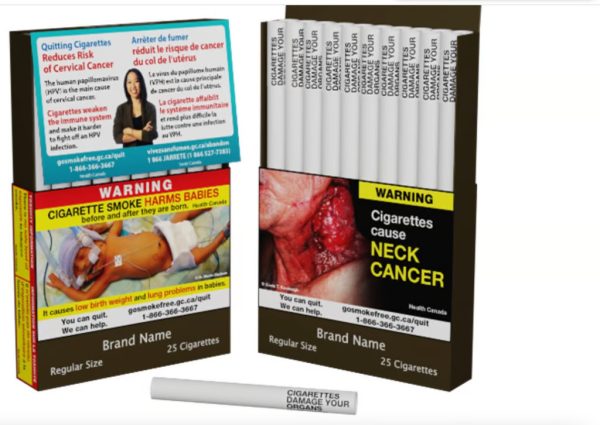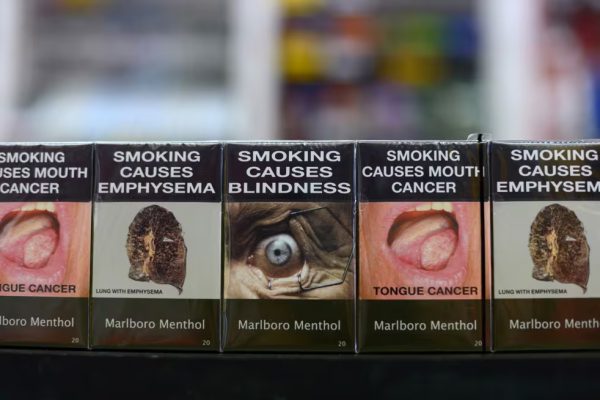Since at least the early 1960s, scientists have issued dire warnings about the severe health consequences of smoking cigarettes.
Cigarette and vape packaging, however, has never gone far enough or been nearly graphic enough.
One case in point: The popular American cigarette brand Marlboro sells its menthol cigarettes in a stylish, brightly colored packaging, advertising the product with an enticing “Fresh Menthol Flavor.”
Instead, all cigarette and vape packaging in the U.S. should come with bold warnings and images of diseased lungs to clearly communicate to consumers about the dangers of cigarette use.
Over 49 million adults and 2.25 million youths under 18 currently use tobacco products in the U.S., and cigarette and vape use has been tied to nearly 480,000 deaths every year.
Cigarette use is closely linked to various diseases including lung cancer, due to the of dangerous chemicals in cigarettes and vapes like nicotine that are highly addictive and toxic. E-cigarettes and vapes are proven to produce dangerous chemicals including acetaldehyde, acrolein, and formaldehyde that lead to lung disease.
The reality of using these products should be clear and prominent to see on the packaging, so that teens — the main group of potential new consumers — will actually understand the health risks. Currently, most warning labels about the consequences of cigarette use are displayed not very prominently on the sides of packaging.
To a potential consumer who is casually browsing in a store aisle, they may not internalize the warnings unless there is a shocking image and bold warning on the front, as is done commonly in countries such as Canada and Australia. Labeling packaging with explicit graphic images like dead lungs would encourage young people to think twice before indulging in a life-threatening habit. Here is what that labeling looks like:


Of course, implementing frightening warnings on cigarette packaging wouldn’t be as effective with longtime smokers. When people use nicotine on a daily basis, their body becomes dependent and suffers physical and mental withdrawal symptoms when they try to stop.
Over time, more nicotine is required to achieve the same dopamine effect, and thus their tolerance increases, making it incredibly difficult to quit even if they want to. While this is not to say stopping an existing addiction is impossible, it’s more effective in targeting the younger generation.
Outside of the U.S., warning labels have been effective at reducing usage and informing young generations about the risks of smoking and vaping. Current legislation in other countries requires labels to take up a certain amount of space on the packaging, such as the EU designating 65% of it to be a warning label. Well-designed labels and graphics have been effective at conveying the health concerns in smoking, resulting in a higher rate of quitting and a decrease in starting smoking and vaping.
In Nepal, a survey of 2,250 participants was conducted and showed that 80.2% of participants believed that the labels will help smokers quit, 86.8% of participants believe that labels will deter new smokers from starting and 58% of active smokers in the poll intended to quit and reduce their average intake from 11 to 5 cigarettes a day.
Some brands say they don’t feel obligated to display pictures of what might happen if their consumers use their products as they claim most smokers know the adverse effects of smoking. Moreover, many brands believe that these warnings infringe on intellectual property rights in the World Trade Organization and other international trade agreements; however, advertising warnings on cigarette packaging has not violated any requirements and governments have been able to overcome all these arguments.
Another complaint about using more dire cigarette warnings in the U.S. centers around censorship and freedom of speech under the First Amendment, but the 5th U.S. Circuit Court of Appeals has found that “factual and uncontroversial” FDA warnings do not impede on the First Amendment in any way.
On a more ironic note, this court controversy shows the hypocrisy of the tobacco industry, claiming they are reducing the harm caused by cigarettes and vapes yet lobbying against it in the court. They fight the usage of warnings on their packaging, which has been proven to help smokers quit and prevent new smokers.
Fortunately, the U.S. has already been taking steps to change cigarette use, more than 35 years after the U.S. Surgeon General’s warning for smoking in 1984. Since June 2021, the Food and Drug Administration requires graphic images of health consequences on cigarette packaging “occupying the top 50% of the area of the front and rear panels of cigarette packages and at least 20% of the area at the top of cigarette advertisements.”
The FDA finalized a set of 11 required warnings, including “WARNING: Tobacco smoke can harm your children” and “WARNING: Smoking reduces blood flow to the limbs, which can require amputation.”
Putting even more graphic warning labels on each cigarette package sold will directly connect their actions to the health consequences, and with enough time, this addiction of smoking might not be the public health crisis that it is today. If we can stop prospective consumers at the marketing level, the trajectory of preventable disease and death associated with smoking may finally look much more hopeful.




























